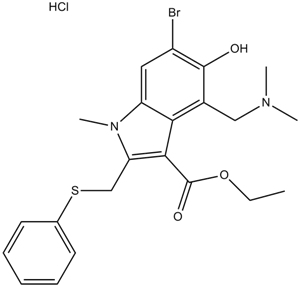This product is for research use only, not for human use. We do not sell to patients.

| Size | Price | Stock |
|---|---|---|
| 10g | $750 | Check With Us |
| 25g | $1300 | Check With Us |
| 50g | $1950 | Check With Us |
Cat #: V2388 CAS #: 131707-23-8 Purity ≥ 98%
Description: Umifenovir (trade name Arbidol) HCl, the hydrochloride salt of umifenovir, is a broad-spectrum antiviral drug that blocks viral fusion, and was approved for use in Russia and China for the treatment of influenza and other respiratory viral infections. Arbidol inhibits the cell entry of HCV pseudoparticles of genotypes 1a, 1b, and 2a in a dose-dependent fashion. Arbidol also displays a dose-dependent inhibition of HCV membrane fusion, as assayed by using HCV pseudoparticles (HCVpp) and fluorescent liposomes. Arbidol is found to present potent inhibitory activity against enveloped and non-enveloped RNA viruses, including FLU-A, RSV, HRV 14 and CVB3 when added before, during, or after viral infection, with IC50 ranging from 2.7 to 13.8 mg/mL.
References: [1]. Boriskin YS, et al. Arbidol: a broad-spectrum antiviral compound that blocks viral fusion. Curr Med Chem. 2008;15(10):997-1005.
Publications Citing InvivoChem Products
Product Promise

- Physicochemical and Storage Information
- Protocol
- Related Biological Data
- Stock Solution Preparation
- Quality Control Documentation
| Molecular Weight (MW) | 513.88 |
|---|---|
| Molecular Formula | C22H25BrN2O3S.HCl |
| CAS No. | 131707-23-8 |
| Storage | -20℃ for 3 years in powder formr |
| -80℃ for 2 years in solvent | |
| Solubility In Vitro | DMSO: 103 mg/mL (200.4 mM)r |
| Water: <1 mg/mLr | |
| Ethanol: 22 mg/mL (42.8 mM) | |
| SMILES Code | O=C(C1=C(CSC2=CC=CC=C2)N(C)C3=C1C(CN(C)C)=C(O)C(Br)=C3)OCC.[H]Cl |
| Synonyms | Umifenovir hydrochloride; arbidol |
| Protocol | In Vitro | In vitro activity: Arbidol inhibits the cell entry of HCV pseudoparticles of genotypes 1a, 1b, and 2a in a dose-dependent fashion. Arbidol also displays a dose-dependent inhibition of HCV membrane fusion, as assayed by using HCV pseudoparticles (HCVpp) and fluorescent liposomes. Arbidol is found to present potent inhibitory activity against enveloped and non-enveloped RNA viruses, including FLU-A, RSV, HRV 14 and CVB3 when added before, during, or after viral infection, with IC50 ranging from 2.7 to 13.8 mg/mL. Arbidol shows selective antiviral activity against AdV-7, a DNA virus, only when added after infection (therapeutic index (TI) = 5.5).Arbidol induces changes to viral mRNA synthesis of the PB2, PA, NP, NA, and NS genes in MDCK cultures infected with influenza A/PR/8/34. Arbidol interacts and modifies the physicochemical properties of the phospholipids in the membrane, having a significant effect on negatively charged phospholipids but a minor one on zwitterionic phospholipids. Arbidol is located at the interface of the membrane, participates in hydrogen bonding either with water or the phospholipid or both, and decreases the hydrogen bonding network of the phospholipids giving place to a phospholipid phase similar to the dehydrated solid one. |
|---|
| Solvent volume to be added | Mass (the weight of a compound) | |||
|---|---|---|---|---|
| Mother liquor concentration | 1mg | 5mg | 10mg | 20mg |
| 1mM | 1.9460 mL | 9.7299 mL | 19.4598 mL | 38.9196 mL |
| 5mM | 0.3892 mL | 1.9460 mL | 3.8920 mL | 7.7839 mL |
| 10mM | 0.1946 mL | 0.9730 mL | 1.9460 mL | 3.8920 mL |
| 20mM | 0.0973 mL | 0.4865 mL | 0.9730 mL | 1.9460 mL |
This equation is commonly abbreviated as: C1 V1 = C2 V2
- (1) Please be sure that the solution is clear before the addition of next solvent. Dissolution methods like vortex, ultrasound or warming and heat may be used to aid dissolving.
- (2) Be sure to add the solvent(s) in order.




































